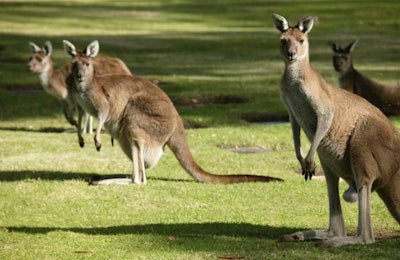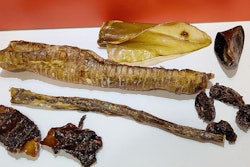
Kangaroo may seem a novel ingredients to the global pet food industry, but dogs have dined on marsupial meat and co-products for thousands of years. Dingos have eaten kangaroo for a long time, but only recently have other dogs gotten the opportunity.
Wag, a dog treat brand, uses several kangaroo organ meats, along with other kangaroo cuts not in high demand among humans, like the tail bones. Wag uses three organ meats from marsupials: the heart, high in zinc and omega-3 and -6 omega acids, the lungs, with iron, zinc and fatty acids, and the liver, which can be broken apart as a training treat.
“When you look at animals in the wild, they tend to go after the organ meats first because there's just a lot of nutrients there,” David Charlson, CEO and president of North American sales for Wag, said. “We wanted to make sure that we use the whole animal not just the muscle meat. We also use other parts like different bones.”
That includes the bones and tendons of the kangaroo’s tail after the meat has been taken for human consumption. Humans get most of the muscle meat from the kangaroos. Wag gets their dog treat and chew ingredients from a facility that processes kangaroos for human markets. By using the bones, organs and other by-products, pet food companies increase the overall economic value of the animal, while reducing waste.
“The thing I'm proud of is that it's a very sustainable hunting practice,” said. “It's very heavily regulated, and they actually do a lot of scientific survey to make sure. There's always a quota every year of how many can be hunted. Right now, the hunters aren't able to meet the quota.”
Pet food and treat import, export during pandemic
The ongoing COVID-19 pandemic disrupted many shipping and other logistics for the pet food industry, and Wag wasn’t immune.
“We've been doing importing into Canada and the U.S. for four years, so as far as our permits go we have no issues,” he said. “We've definitely had port delays going out of Australia, and then going both into Canada and the U.S. we've had anywhere from 30 to even 90 day delays during the worst of it. It's made me change my supply chain management. I'm trying to stay ahead of the curve and forecast further in advance.
“I just had a shipment arrive in Canada, I'm already planning for the next step right now, whereas before I would wait 30 days,” he said. “Now, I'm like trying to stay ahead of it. I’ve had to stay proactive more than I ever used to before.”
While challenges remain for pet food companies using kangaroo meat and co-products, larger challenges once faced the animals themselves.
Kangaroo meat hunting for humans and pets
After approximately 46,000 years of coexistence with Aboriginal Australians and their dogs, several kangaroo species were nearly wiped out following the 1788 establishment of the first British penal colony on the island, as documented in the journal Animals. Along with direct hunting of kangaroos for meat and leather, non-native livestock and invasive species devastated ecosystems that the marsupials depended upon. For more than a century and a half, the expansion of the English and other Europeans into Aboriginal lands disrupted Australia’s cultures and ecosystems largely without restraint. In the 1970’s, a conservation movement began to protect the kangaroos. Australia’s Environment Protection and Biodiversity Conservation Act of 1999 protects kangaroos.
Four kangaroo species, along with two wallabies, have now rebounded enough to allow regulated hunting of the marsupials. In some regions, the kangaroos have become abundant enough to overgraze the landscape, according to the Kangaroo Industry Association of Australia, especially when droughts follow good years that allowed kangaroo populations to boom.
Hunters can take red kangaroo (Macropus rufus), western grey kangaroo (Macropus fuliginosus), eastern grey kangaroo (Macropus giganteus) and common wallaroo (Macropus robustus). Officials set quotas for how many of each animal can be hunted in a single year. Animal welfare proponents have claimed that these hunts can result in the deaths of young kangaroos, or joeys, when the mothers are killed. However, kangaroo hunting advocates counter that regulations stipulate that commercial hunters must immediately euthanized these orphaned animals by decapitation or a blow to the head. The alternative would be worse for the animals, they claim, if the kangaroos were to starve to death after overgrazing an area.
While farmers and ranchers once eradicated kangaroos to reduce competition with livestock, some believe that getting rid of the cows and sheep could be a better long-term choice for Australia. Managing land for kangaroo harvesting could help restore ecosystems damaged by the hard-hooves and intensive grazing of non-native livestock. Similarly, these kangaroo management operation could incorporate Aboriginal experience and tradition, creating economic opportunities for those who have lived with kangaroos since the Dream Time.
















